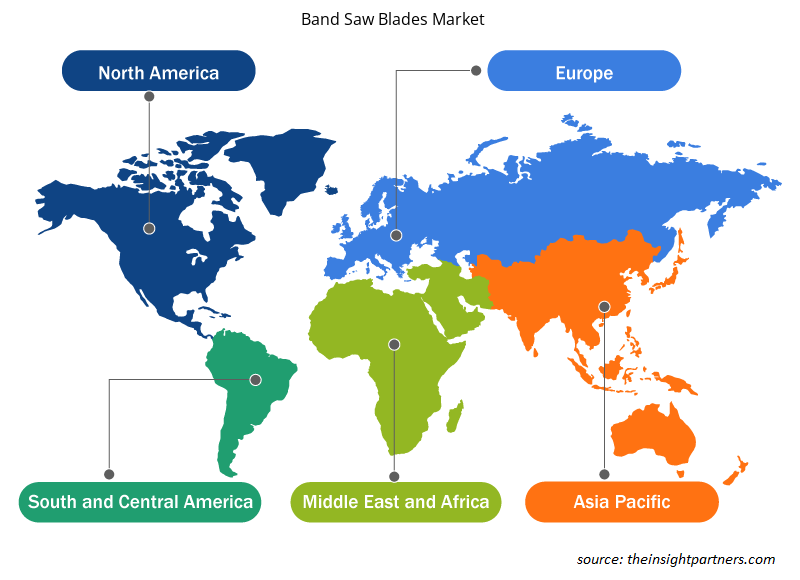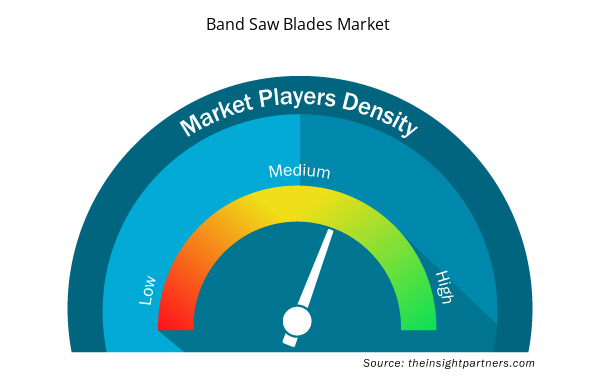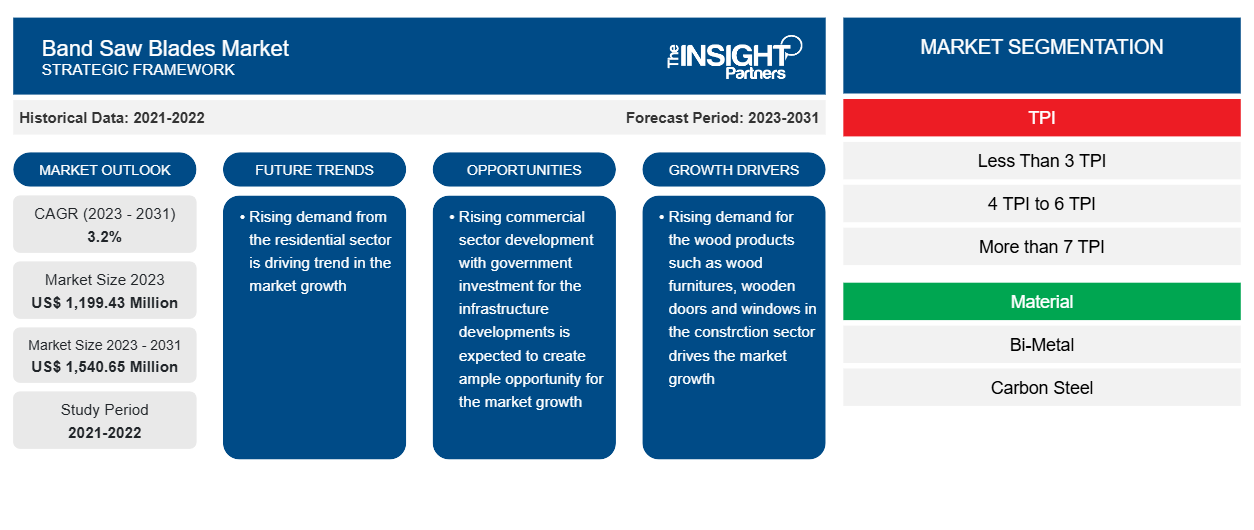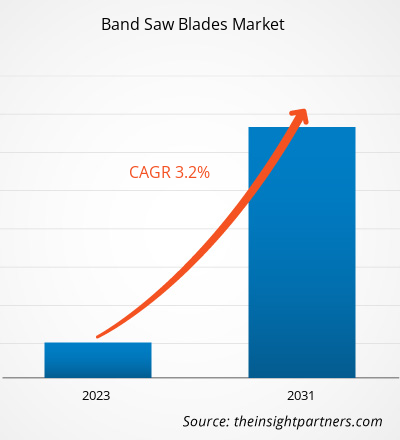带锯条市场规模预计将从 2023 年的 11.9943 亿美元增至 2031 年的 15.4065 亿美元。预计 2023-2031 年市场复合年增长率为 3.2%。
带锯条在木工和金属加工行业中得到广泛应用,因为对用于再锯切和切割较厚材料的粗齿锯条(2 或 3 TPI)以及用于金属切割的金刚石锯条或铁质锯条的需求不断增长。木工行业的重要工序包括木材和其他森林资源的采伐和加工、伐木、木工以及纸浆和造纸加工。该行业的企业生产建筑、农业和食品行业使用的成品。带锯条用于进行木材的初级加工。
带锯条市场分析
带锯刀片适用于不同行业,包括农业、家具切割和金属切割制造。带锯刀片安装在包含轮子和马达的机器上。这些带锯刀片用于锯切和切割硬质金属,如钴、锆、镍、铁、钛、木材、沥青、混凝土、大理石、花岗岩和其他金属。这些刀片耐磨且无腐蚀,与钴、镍和碳钢合金化以提高其强度。
带锯条市场概况
带锯刀片是一种可更换的齿形切割刀片,用于许多手持设备以及便携式和固定式电动工具。欧洲的木材工业是值得注意的行业之一,因为它为该地区的经济做出了很大贡献。欧洲的木材工业包括广泛的下游业务,例如木工、家具行业的重要部门、纸浆和造纸制造和加工行业以及印刷行业。根据欧盟统计局 2022 年提供的数据,2020 年欧盟木材工业的总增加值 (GVA) 为 1360 亿欧元,占整个制造业的 7.2%。2020 年,生产木材和木制品的总增加值为 370 亿欧元。据报道,欧盟木材工业中 GVA 最高的是纸浆、纸张和纸制品生产(34% 或 460 亿欧元)。印刷和印刷相关服务活动占木质工业GVA的16%,而家具制造和木材及木制品制造分别占23%至27%。
定制此报告以满足您的需求
您可以免费定制任何报告,包括本报告的部分内容、国家级分析、Excel 数据包,以及为初创企业和大学提供优惠和折扣
- 获取此报告的关键市场趋势。这个免费样品将包括数据分析,从市场趋势到估计和预测。
带锯条市场驱动因素和机遇
全球木工和金属加工工艺的增加推动了市场增长
该行业的企业生产建筑、农业和食品行业使用的成品。带锯条用于进行初级木材加工。金属加工技术的进步增加了对减振降噪设备和工具的需求。设备的舒适性和易操作性是金属加工中的一个重要考虑因素。因此,对耐用带锯条的需求不断增加,这些带锯条具有较长的使用寿命,可以防止故障和停机。数控机床制造工艺的兴起促进了工业金属加工行业的增长。数控技术的出现、技术进步、产品的创新发展以及对电动工具和机器人木工机械的需求不断增长是推动带锯条市场增长的其他因素。此外,先进技术的日益普及推动了木材和金属加工行业带锯条的销售。
在木工行业拥有丰富经验的市场参与者正与木工公司密切合作,开发、现代化和自动化他们的产品,并实施系统来检查产品质量和生产诊断。家具行业的增长显著。木工机械市场在美国和中国正在增长。木工行业的其他主要市场包括日本、加拿大和德国,这推动了全球带锯条市场规模的增长。
发展中经济体建设项目扩张
亚太、中东和南美经济体对带锯条的需求正在激增,用于切割、组装和修复木材和金属结构。未来几年,亚太地区预计将在带锯条市场中处于领先地位,因为该地区的锯条销量正在增加,这是由于建筑项目数量的增加。例如,中国上海的上海芯片制造厂是 2022 年第一季度亚太地区启动的最大建设项目之一。该建设工程预计将于 2024 年完工。同样,为满足对集成电路产品日益增长的需求,中国北京的 12 英寸晶圆和集成电路封装厂的建设预计将于 2024 年完工。在印度,金属加工正在快速增长,用于制造大型船舶、汽车零件和许多终端行业的单个零件、组件和大型金属模具,这增加了对用于成型、切割和连接模具的带锯条的需求。此外,由于汽车和建筑行业的需求不断增长,以及政府对基础设施建设的日益重视,该国对钢铁的需求也在增加。据业内官员称,专用货运走廊项目、新高速和半高速项目以及机车车辆采购的增长将推动钢铁消费。
带锯条市场报告细分分析
有助于得出带锯条市场分析的关键部分是 TPI、材料和应用。
- 根据 TPI,市场分为小于 3 TPI、4 TPI 至 6 TPI 和大于 7 TPI。4 TPI 至 6 TPI 锯片用于切割低碳钢或退火材料的应用日益增多,推动了该细分市场的增长。4tpi 至 6tpi 细分市场的市场参与者考虑到壁厚提供了理想的齿数,以消除过早的锯片磨损或电机故障。预计这些因素将推动全球带锯片市场中 4 TPI 至 6 TPI 细分市场的增长。
- 根据材料,市场分为双金属、碳钢和其他。其中,双金属在 2023 年占有最大份额。
- 根据应用,市场分为木材切割和肉类加工。由于住宅家具中的应用增加,木材切割将成为 2023 年的主导领域。
带锯条市场份额按地区分析
带锯条市场报告的地理范围主要分为五个区域:北美、亚太、欧洲、中东和非洲、南美/南美和中美。
由于人口不断增长、人们的消费能力不断提高以及该地区发展中国家快速的城市化,北美预计将占据市场主导地位。带锯条制造商正在开发新产品,为各种金属切割应用提供高质量的切割。产品创新战略主要侧重于提高精密金属切割刀片的性能和耐用性。金属切割市场的激烈竞争是鼓励制造商采用产品创新战略的关键因素之一。一家领先的带锯和手锉产品制造商推出了一系列新型双金属带锯条,这些锯条设计有特定的深度,适用于所有金属切割应用,包括通用切割、生产切割、低碳钢切割和特殊合金的韧性切割。
带锯条市场区域洞察
Insight Partners 的分析师已详尽解释了预测期内影响带锯条市场的区域趋势和因素。本节还讨论了北美、欧洲、亚太地区、中东和非洲以及南美和中美洲的带锯条市场细分和地理位置。

- 获取带锯条市场的区域特定数据
带锯条市场报告范围
| 报告属性 | 细节 |
|---|---|
| 2023 年的市场规模 | 11.9943亿美元 |
| 2031 年市场规模 | 15.4065亿美元 |
| 全球复合年增长率(2023 - 2031) | 3.2% |
| 史料 | 2021-2022 |
| 预测期 | 2023-2031 |
| 涵盖的领域 | 通过TPI
|
| 覆盖地区和国家 | 北美
|
| 市场领导者和主要公司简介 |
|
市场参与者密度:了解其对商业动态的影响
带锯条市场正在快速增长,这得益于终端用户需求的不断增长,而这些需求又源于消费者偏好的不断变化、技术进步以及对产品优势的认识不断提高等因素。随着需求的增加,企业正在扩大其产品范围,进行创新以满足消费者的需求,并利用新兴趋势,从而进一步推动市场增长。
市场参与者密度是指在特定市场或行业内运营的企业或公司的分布情况。它表明在给定市场空间中,相对于其规模或总市场价值,有多少竞争对手(市场参与者)存在。
在带锯条市场运营的主要公司有:
- BAHCO (SNA 欧洲)
- 东北特钢集团有限公司
- 弗里德里希比肯巴赫有限公司
- 公斤
- Gi-Esse 萨尔瓦多有限公司
- HABUR-SAWS 有限公司
免责声明:上面列出的公司没有按照任何特定顺序排列。

- 获取带锯条市场顶级关键参与者概述
带锯条市场新闻和最新发展
通过收集主要和次要研究后的定性和定量数据来评估带锯条市场,其中包括重要的公司出版物、协会数据和数据库。以下是市场创新、业务扩展和战略发展情况的列表:
- Diablo Tools(“Diablo”)为专业用户提供一系列面向解决方案的全球一流和最适合我们世界的产品,它在振荡多功能工具(“OMT”)市场推出了另一项行业首创产品:用于嵌钉木材的 AMPED™ Demo Demon™ 硬质合金齿刀片。这款首创的硬质合金 OMT 刀片专为嵌钉木材而设计,可为专业人士提供特定应用的优势和改变游戏规则的创新。(来源:公司新闻稿,2024 年 4 月)
- KR Saws 子公司 Roentgen 是德国著名的工业切割解决方案领导者,该公司推出了专为锯切镍基合金而量身定制的最新创新产品。Roentgen Fit Set 和 Fit 带锯刀片经过精心设计和制造,可提高切割性能、延长刀具寿命并消除传统磨合程序的需要,最终为金属制造商和工程师节省宝贵的时间和资源。镍基合金(例如 Inconel 718 和 625)以其出色的强度、耐腐蚀性和高温性能而闻名,对传统切削工具具有挑战性。(来源:公司新闻稿,2024 年 3 月)
带锯条市场报告覆盖范围和交付成果
“带锯条市场规模和预测(2023-2031)”报告对市场进行了详细的分析,涵盖以下领域:
- 带锯条市场规模及全球、区域和国家层面所有主要细分市场的预测
- 市场动态,如驱动因素、限制因素和关键机遇
- 带锯条市场趋势
- 详细的PEST分析和SWOT分析
- 带锯条市场分析涵盖主要市场趋势、全球和区域框架、主要参与者、法规和最新的市场发展。
- 带锯条市场行业格局和竞争分析,涵盖市场集中度、热图分析、知名参与者和最新发展。
- 详细公司简介
- 历史分析(2 年)、基准年、预测(7 年)及复合年增长率
- PEST 和 SWOT 分析
- 市场规模价值/数量 - 全球、区域、国家
- 行业和竞争格局
- Excel 数据集



Report Coverage
Revenue forecast, Company Analysis, Industry landscape, Growth factors, and Trends

Segment Covered
This text is related
to segments covered.

Regional Scope
North America, Europe, Asia Pacific, Middle East & Africa, South & Central America

Country Scope
This text is related
to country scope.
常见问题
The band saw blades market size is projected to reach US$ 1,540.65 million by 2031.
The rising adoption of wood-cutting blades in residential furniture making is a driving trend in the market.
BAHCO (SNA Europe), Dongbei Special Steel Group Co.,Ltd, Friedrich Bickenbach GmbH & Co., KG, Gi - Esse Salvador S.r.l, HABUR -SAWS GmbH, KYOCERA UNIMERCO, LENOX, NACHI FUJIKOSHI CORP, The Bandsaw Shop, and Others
An increase in woodworking and metalworking processes across the globe drives market growth
North America is expected to dominate the band saw blades market in 2023.
The market is expected to register a CAGR of 3.2% in 2023–2031
Trends and growth analysis reports related to Manufacturing and Construction : READ MORE..
The Insight Partners performs research in 4 major stages: Data Collection & Secondary Research, Primary Research, Data Analysis and Data Triangulation & Final Review.
- Data Collection and Secondary Research:
As a market research and consulting firm operating from a decade, we have published and advised several client across the globe. First step for any study will start with an assessment of currently available data and insights from existing reports. Further, historical and current market information is collected from Investor Presentations, Annual Reports, SEC Filings, etc., and other information related to company’s performance and market positioning are gathered from Paid Databases (Factiva, Hoovers, and Reuters) and various other publications available in public domain.
Several associations trade associates, technical forums, institutes, societies and organization are accessed to gain technical as well as market related insights through their publications such as research papers, blogs and press releases related to the studies are referred to get cues about the market. Further, white papers, journals, magazines, and other news articles published in last 3 years are scrutinized and analyzed to understand the current market trends.
- Primary Research:
The primarily interview analysis comprise of data obtained from industry participants interview and answers to survey questions gathered by in-house primary team.
For primary research, interviews are conducted with industry experts/CEOs/Marketing Managers/VPs/Subject Matter Experts from both demand and supply side to get a 360-degree view of the market. The primary team conducts several interviews based on the complexity of the markets to understand the various market trends and dynamics which makes research more credible and precise.
A typical research interview fulfils the following functions:
- Provides first-hand information on the market size, market trends, growth trends, competitive landscape, and outlook
- Validates and strengthens in-house secondary research findings
- Develops the analysis team’s expertise and market understanding
Primary research involves email interactions and telephone interviews for each market, category, segment, and sub-segment across geographies. The participants who typically take part in such a process include, but are not limited to:
- Industry participants: VPs, business development managers, market intelligence managers and national sales managers
- Outside experts: Valuation experts, research analysts and key opinion leaders specializing in the electronics and semiconductor industry.
Below is the breakup of our primary respondents by company, designation, and region:

Once we receive the confirmation from primary research sources or primary respondents, we finalize the base year market estimation and forecast the data as per the macroeconomic and microeconomic factors assessed during data collection.
- Data Analysis:
Once data is validated through both secondary as well as primary respondents, we finalize the market estimations by hypothesis formulation and factor analysis at regional and country level.
- Macro-Economic Factor Analysis:
We analyse macroeconomic indicators such the gross domestic product (GDP), increase in the demand for goods and services across industries, technological advancement, regional economic growth, governmental policies, the influence of COVID-19, PEST analysis, and other aspects. This analysis aids in setting benchmarks for various nations/regions and approximating market splits. Additionally, the general trend of the aforementioned components aid in determining the market's development possibilities.
- Country Level Data:
Various factors that are especially aligned to the country are taken into account to determine the market size for a certain area and country, including the presence of vendors, such as headquarters and offices, the country's GDP, demand patterns, and industry growth. To comprehend the market dynamics for the nation, a number of growth variables, inhibitors, application areas, and current market trends are researched. The aforementioned elements aid in determining the country's overall market's growth potential.
- Company Profile:
The “Table of Contents” is formulated by listing and analyzing more than 25 - 30 companies operating in the market ecosystem across geographies. However, we profile only 10 companies as a standard practice in our syndicate reports. These 10 companies comprise leading, emerging, and regional players. Nonetheless, our analysis is not restricted to the 10 listed companies, we also analyze other companies present in the market to develop a holistic view and understand the prevailing trends. The “Company Profiles” section in the report covers key facts, business description, products & services, financial information, SWOT analysis, and key developments. The financial information presented is extracted from the annual reports and official documents of the publicly listed companies. Upon collecting the information for the sections of respective companies, we verify them via various primary sources and then compile the data in respective company profiles. The company level information helps us in deriving the base number as well as in forecasting the market size.
- Developing Base Number:
Aggregation of sales statistics (2020-2022) and macro-economic factor, and other secondary and primary research insights are utilized to arrive at base number and related market shares for 2022. The data gaps are identified in this step and relevant market data is analyzed, collected from paid primary interviews or databases. On finalizing the base year market size, forecasts are developed on the basis of macro-economic, industry and market growth factors and company level analysis.
- Data Triangulation and Final Review:
The market findings and base year market size calculations are validated from supply as well as demand side. Demand side validations are based on macro-economic factor analysis and benchmarks for respective regions and countries. In case of supply side validations, revenues of major companies are estimated (in case not available) based on industry benchmark, approximate number of employees, product portfolio, and primary interviews revenues are gathered. Further revenue from target product/service segment is assessed to avoid overshooting of market statistics. In case of heavy deviations between supply and demand side values, all thes steps are repeated to achieve synchronization.
We follow an iterative model, wherein we share our research findings with Subject Matter Experts (SME’s) and Key Opinion Leaders (KOLs) until consensus view of the market is not formulated – this model negates any drastic deviation in the opinions of experts. Only validated and universally acceptable research findings are quoted in our reports.
We have important check points that we use to validate our research findings – which we call – data triangulation, where we validate the information, we generate from secondary sources with primary interviews and then we re-validate with our internal data bases and Subject matter experts. This comprehensive model enables us to deliver high quality, reliable data in shortest possible time.


 获取此报告的免费样本
获取此报告的免费样本